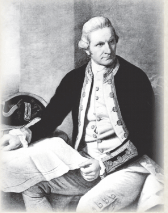WHO IS JAMES COOK?
If you decide to visit somewhere you’ve never been before, how do you find your way? If you’re in a car, the driver might use a GPS. You might use a smartphone app to give you directions. Perhaps you might go really ‘old school’ and use a printed map or street directory. But how did explorers navigate their way around the globe over 200 years ago? James Cook was one of the greatest navigators of his time. His love of mathematics, astronomy and attention to detail resulted in some of the most accurately charted maps ever made. How did he achieve this? And why? Cook, an Englishman, lived during the 1700s when life was quite different from today. The populations of countries were smaller and people didn’t use to travel very far from where they lived and worked, but they had a huge thirst for knowledge . Exploration was a challenging and exciting way to discover new countries and, by 1768, James Cook became known as an excellent navigator and seaman. In this year, he sailed to Tahiti to observe the planet Venus as it passed between the Earth and the Sun. During this expedition, he also mapped New Zealand and the eastern coast of Australia. The maps which were charted by Cook and other explorers allowed sailors to find their way accurately across the oceans of the world, and journeys of exploration became a popular interest for the people back home. They developed a huge interest in geography, astronomy and science as the stories of exploration started to make the world feel just a little bit smaller. In the 1700s, traditional instruments which helped to guide and track ships were improved and new ones were invented. For centuries, it was quite challenging for a captain to navigate his ship. Cook used the new instruments when he set sail for the Pacific. During his lifetime, James Cook made three voyages to the Pacific visiting Tahiti, Tonga and many islands that were unknown before that time. He wasn’t just charting maps, though. Scientists, botanists and artists also travelled with him to study landforms and cultures. Centuries after James Cook’s death, his name and achievements are still remembered. Over the years, his memory has been celebrated in many ways: monuments, medallions, place names, public buildings and so on. Some of this memorabilia exists in the form of items used by Cook and passed on to others, and has a direct link to his work as a navigator and explorer.

